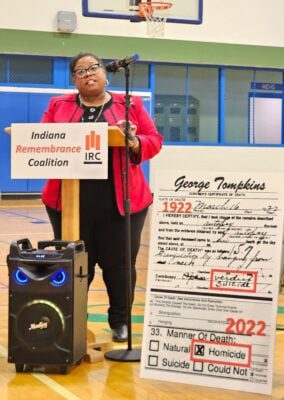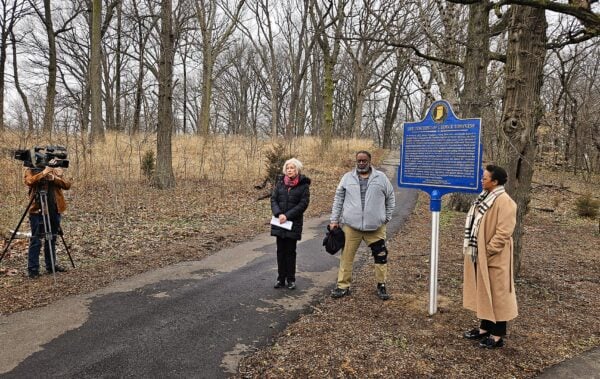A ceremony at Municipal Gardens Family Center honored the life of George Tompkins, a 19-year-old Black man lynched in Indianapolis in 1922.
Local leaders and the Equal Justice Initiative (EJI) unveiled a historic marker acknowledging the tragedy as part of a broader effort to confront racial injustice.
Tompkins’s body was discovered in Riverside Park on March 16, 103 years ago, with hands tied behind his back and a rope around his neck fastened to a small tree. Despite clear evidence of foul play, police labeled the death a suicide, a conclusion the coroner initially supported despite telling reporters, “The man could not have hanged himself.”

Yet the investigation abruptly ended, and the story disappeared from public attention.
“George Tompkins deserved better. And while we cannot change the past, we can ensure that his name is spoken, his story is remembered and his legacy endures,” said Alfie McGinty, Marion County Coroner.
McGinty, who previously worked to revise Tompkins’s death certificate to reflect “homicide,” called the correction “more than an administrative act.”
The marker, initiated by the Indiana Remembrance Coalition (IRC) and provided by EJI, is situated near the Municipal Gardens Family Center. It recounts how, during the post-World War I era, authorities often mischaracterized racial killings as suicides to avoid investigations and shield perpetrators.
Tompkins’s case remains unsolved, and the motive for his killing is unknown. Unlike many lynching victims, he was not even accused of a crime.
“More than 100 years after this dark chapter in Indianapolis history, this marker at Municipal Gardens honoring the life of George Tompkins is long overdue,” said Deputy Mayor Judith Thomas in her prepared remarks. “While we cannot right the wrongs of the past, our community can learn and grow from it by telling his story and keeping his memory alive.”

IRC co-chair Karen Christensen announced plans to transform the site into a Memorial Grove Remembrance Garden, supported by a greenspace grant from Keep Indianapolis Beautiful.
“We want to acknowledge the beauty and potential of this area while ensuring that George Tompkins’s story endures,” Christensen said.
EJI staff attorney Stephanie Wylie underscored the broader context of racial terror lynchings, describing them as part of “a wider campaign” to suppress Black communities.
“Healing begins with an honest reckoning of this past,” she said.
Tompkins is one of more than 25 documented victims of racial lynchings in Indiana between 1866 and 1950.
For more information about the Indiana Remembrance Coalition, visit ircoalitioninfo.wordpress.com/blog.
Contact Health & Environmental Reporter Hanna Rauworth at 317-762-7854 or follow her on Instagram at @hanna.rauworth.
Hanna Rauworth is the Health & Environmental Reporter for the Indianapolis Recorder Newspaper, where she covers topics at the intersection of public health, environmental issues, and community impact. With a commitment to storytelling that informs and empowers, she strives to highlight the challenges and solutions shaping the well-being of Indianapolis residents.










